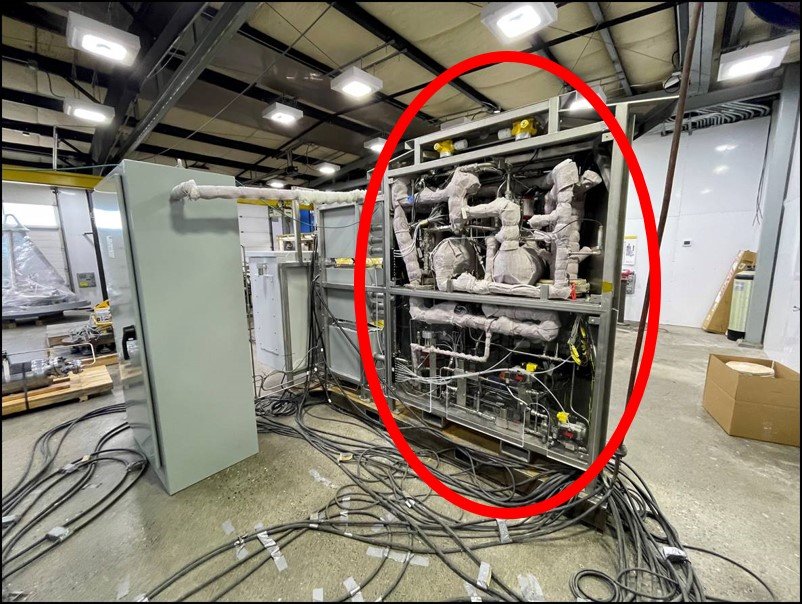Join us at What's new h2
The first commercial-scale demonstration of stars’ clean H2 BioGAs Reformer, Hydrogen generator (pictured above) — currently completing its first year of commercial demonstration at the SunLine Transit Agency in Thousand Palms, CA
World’s First
Highly-Efficient (World Record) Inductive Heating
Process-Intensive, Microchannel Reactors and Heat Exchangers
3D Printed / Additively-Manufactured
Patented and Patent-Pending
Microchannel Process Technology was originally developed at the Department of Energy’s Pacific Northwest National Laboratory. The above, inductively-heated biogas reformer BGR and High Temperature Recuperative Heat Exchanger (HTR),was developed and demonstrated by PNNL and STARS with support from the RAPID Manufacturing Institute for Process Intensification.
The Hydrogen Future is Now
We believe that the 2020s will be The Hydrogen Decade. Just as wind turbines and solar photovoltaics became economically-viable during the last decade — allowing them to compete with fossil-based electricity— we expect the costs of hydrogen and fuel cells to fall over the next several years. Clean, regional “hydrogen hubs” are being established with Federal support over the next five years; fuel cells, already in mass production for some uses, are expected to continue to fall in price as transportation applications are expanded; and distributed, load-following power generation will be enabled that offsets the variable aspects of wind and solar resources. The time is right for the creation of a hydrogen ecosystem. And that is what we are dedicated to achieving.
STARS’ is ready to bring about a future where low-cost, clean hydrogen provides fuel for everyone - everywhere.
STARS was selected as a top-ten, new energy technology venture company at the 2022 Rice Alliance event.
STARS’ Clean H2 Generator
Assembled and Factory-Tested at HiLine Engineering (Richland, WA) — with support from Concept Engineering (Kennewick, WA) and Barr Engineering (CA)
November 2022: 75 kg/day Clean Hydrogen Generator Start of SunLine Pilot Plant Demonstration
Compact, Process-Intensive Microchannel Process Technology: The chemical process module, circled in red, occupies a footprint of just one square meter.
STARS Clean H2 Generator Demonstration Project: H2 SilverSTARS
Southern California Gas Company (SoCalGas) and SunLine Transit Agency hosted an unveiling ceremony and media event on Wednesday, January 18. Speakers at the event included Congressman Raul Ruiz, who represents California’s 25th Congressional District; Lauren Skiver, CEO and General Manager at SunLine Transit Agency; Neil Navin, Vice President of Clean Energy Innovations, SoCalGas; and Robert Wegeng, STARS’ President and Chief Technology Officer.
STARS’ Clean Hydrogen Generators are “chemical transformers”. Converting water and Biogas gas, to Clean Hydrogen.
Mass-produced, STARS’ H2 Generator can readily be set up on the natural gas grid, in close proximity to hydrogen off-takers, such as fleet operators’ filling stations, rapidly creating regional clean and affordable hydrogen resources between and among hydrogen hubs.
Depending on the sources of biogas and electricity, the clean H2 product will be (using GREET methodology) “carbon-negative”.
Near-term applications will include fleet vehicles and energy storage for the electrical grid, with cogeneration using load-following power units, to manage the variability of wind and solar resources.
Potential mid- and later-term applications include air transport, steel refining, co-production of ammonia or other chemicals and solid-carbon products (e.g., carbon fibers, which are stronger and lighter than steel).
STARS Technology Corporation is currently working with Southern California Gas Company and SunLine Transit Agency on a demonstration project that will place two commercial prototype STARS Clean Hydrogen Generators — Beta 1 and Beta 2 — at SunLine’s hydrogen fueling station in Thousand Palms, California. The research project, called “H2 SilverSTARS,” will produce clean hydrogen to fuel SunLine’s fleet of 26 hydrogen fuel cell electric buses and support further expansion.
Lessons learned from the demonstration will be used to develop STARS’s first commercial units beginning in 2025. These mass-producible, units will provide fleet operators 250 kg/day -on site, as they build their fleets of fuel cell electric vans, buses and trucks.
STARS’ Hydrogen Generators are “chemical transformers”. The placement of STARS units on the natural gas grid transforms the existing gas grid into Regional Clean Hydrogen Grids, enables the accelerated rollout of fuel cell electric vehicles, and provides an opportunity for grid electricity storage with co-generation that offsets the variability of wind and solar.
The first unit delivered to SunLine was 75 kg/day hydrogen generator, designated Beta-1. It is capable of producing the hydrogen needed for three of SunLine’s fuel cell buses. The project, called H2 SilverSTARS, produced clean hydrogen from biogas (or renewable natural gas) and water — meeting the new Federal Clean Hydrogen Standard — at any location adjacent where biogas or renewable natural gas is available.
The first two clean H2 generators are commercial prototypes. The intention is to improve the design of the units in SunLine’s real application to improve and evolve the commercial STARS units that can be brought into production during 2025. The near-term goal is to attain low capital costs through economies of hardware mass production so that clean hydrogen can be produced and sold at prices that compete with gasoline and diesel fuel.
Hydrogen-powered fuel cell electric vehicles are expected to play an important role in meeting requirements in California, Washington State, and in many other states, mandating zero-emission vehicles (ZEVs). With the establishment of regional, clean hydrogen hubs, there is an opportunity to aggressively establish thousands of hydrogen filling stations that support the roll-out of fuel cell vehicles throughout the USA by interconnecting and augmenting the central production of hydrogen in the hubs.
Medium- and Heavy-Duty Vehicles are potential early transportation applications of Clean Hydrogen. SunLine Transit Agency, with its 20 year of hydrogen transportation experience, is ideal for demonstrating, improving and evolving the STARS Clean H2 Generators.








